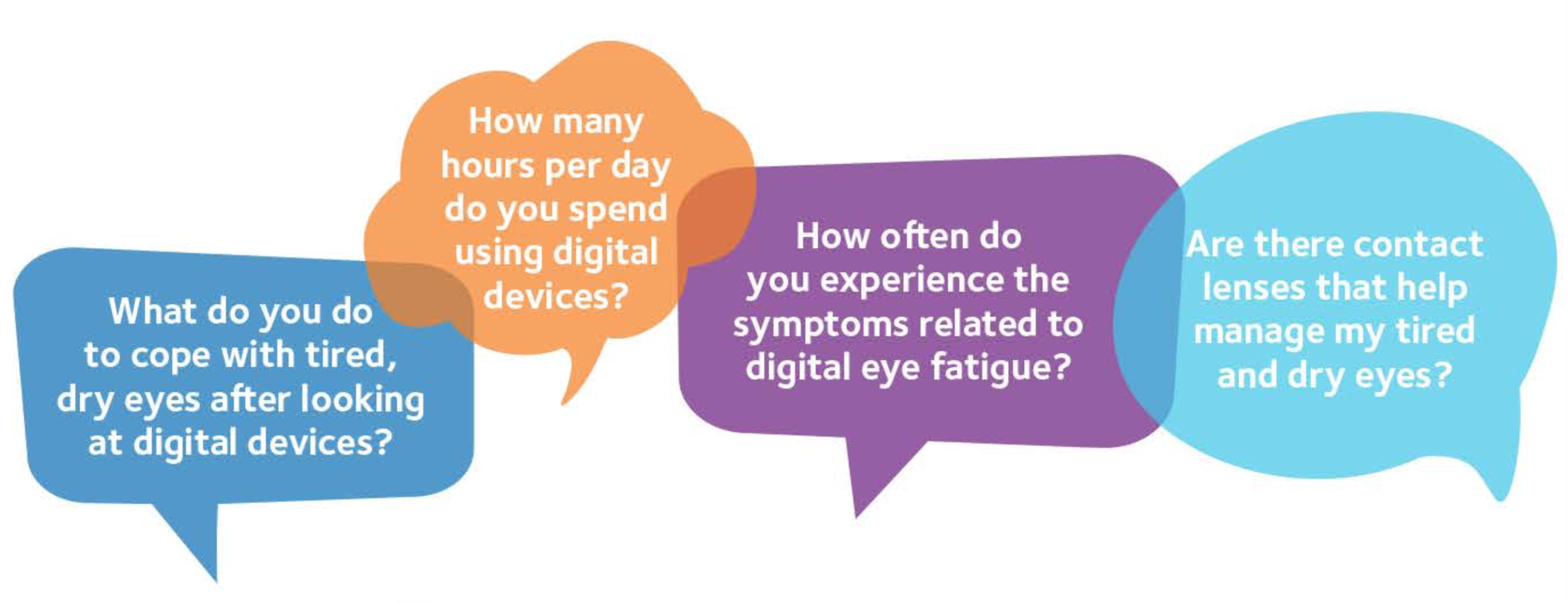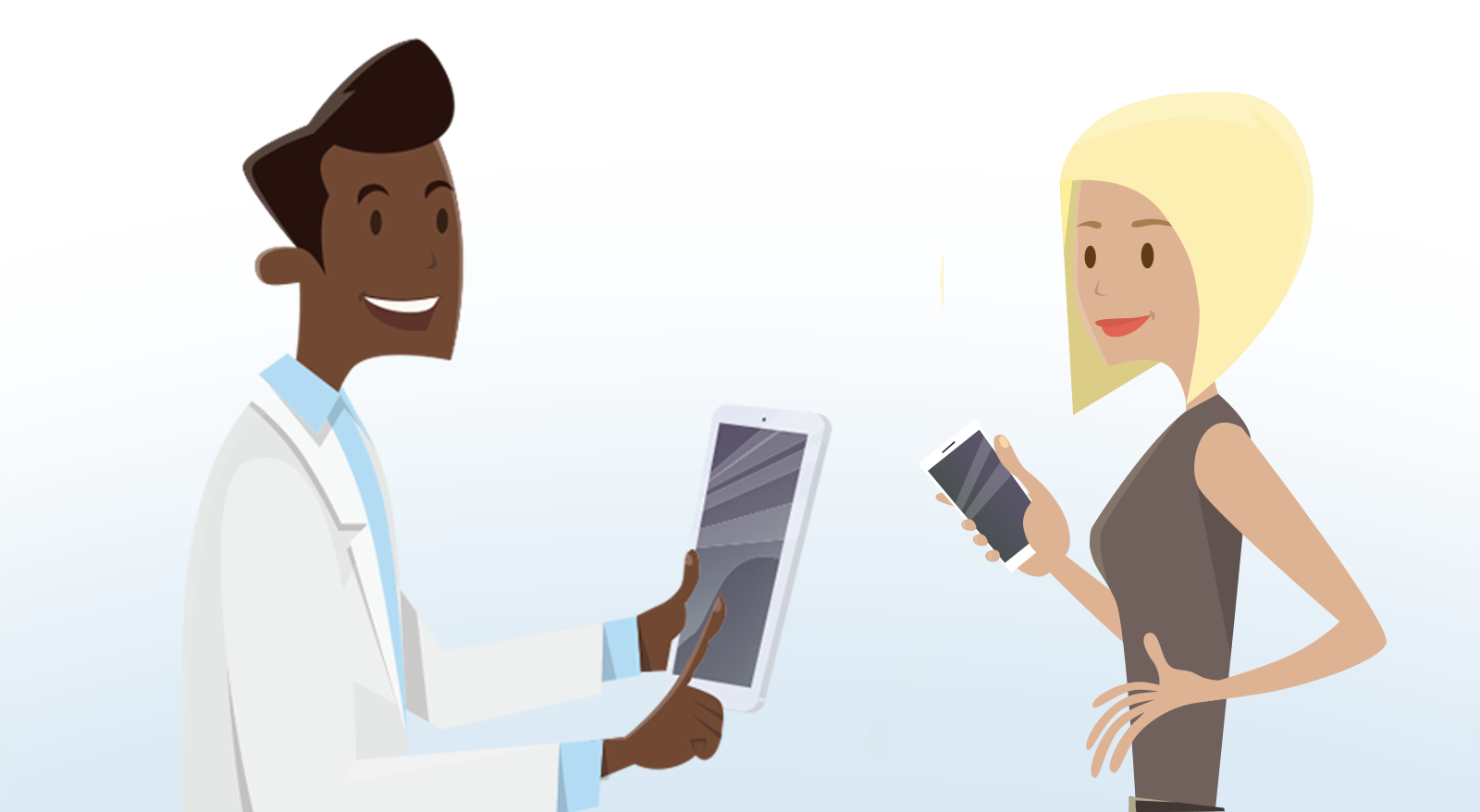Overview of global study on digital eye fatigue
With over 30 years in the contact lens industry, Dr Gary Orsborn sees the growing importance of discussing digital eye fatigue with an eye care professional (ECP).
“Digital device use is increasing each day. People all over the world are looking at more devices for longer periods of time. With this increase in use comes an increase in symptoms associated with digital eye fatigue. These symptoms are typically described as eye tiredness, eye dryness, blurry vision, or just general eye strain. This recent consumer survey, known as the CooperVision® Digital Device Usage and Your Eyes Report, shows the impact is greater on contact lens wearers versus those who don’t wear lenses. Compared to non-contact lens wearers, contact lens wearers are more concerned about the amount of time they spend looking at screens, take less breaks, and admit to using their phone more. While concern is higher among contact lens wearers, there is a lens available that lessens the impact digital device use has on their eyes.
/ didgetl • ai • fe'tig /
1. the ocular discomfort felt in contact lens wearers after 2 or more hours in front of a digital screen
“Results of this survey also show that symptoms and the desire to explore solutions to reduce eye tiredness among contact wearers are consistent across the globe, and yet the conversation between ECPs and patients isn’t happening often enough. We found that one barrier to addressing digital eye fatigue symptoms is the misperception that this issue is an inescapable part of life. We’re working hard to overcome that misperception by bringing awareness to digital eye fatigue through research like this and encouraging patients and ECPs to start the discussion about advanced contact lenses available for their digital lifestyle.”
Gary Orsborn, OD, MS, FAAO, FBCLA
VP, Global Professional & Clinical Affairs
What is the impact of digital device use on the eye?
Digital device use can take a toll on anyone's eyes, ranging from fatigue and strain to dryness and blurry vision. Using digital devices can decrease a person's blink rate, contributing to dryness and discomfort.1 That, combined with lack of regular breaks, improper screen distance, and other factors can all lead to digital eye fatigue. While many people report symptoms associated with screen-time use on their eyes, they may not always use the same terminology to describe what they are feeling.
People report the fatigue they feel after staring at digital screens in different ways*:
- Tired eyes
- Dryness in eyes
- Burning
- Eye irritation
- Soreness in eyes
- Eye strain or pain
- Blurry/double vision
- Headaches
- Tearing/watery eyes
- Text moving/floating
*All symptoms were self-reported findings from the United States, United Kingdom, and Australia only. Data on file.
The global concern of digital device use on the eye
Both contact lens wearers and non-wearers worry about how much they use digital devices
Globally, 19% of people who use vision correction and 18% of people who do not, express concern about the amount of time they spend looking at screens.
While concern among the 2 groups is essentially the same, concern among contact lens wearers is higher globally at 26%. The level of concern among contact lens wearers varies from country to country.
Contact lens wearers from Spain indicated more concern than the global average, while Germany reported little concern.
How are contact lens wearers coping with the discomfort from device use?
Coping strategies vary from country to country
In Japan, respondents are least likely to take a break (36%) and most likely to turn to eye drops (70%) to cope | ||
The United Kingdom reported the highest rate of taking longer breaks (74%) as a way to cope, followed by Australia (72%) |
Among contact lens wearers who feel the effects of staring at screens, common coping strategies include:
Taking a break from the screens for a few minutes or longer | ||
Looking away from the screen for a few seconds | ||
Closing eyes for a few minutes | ||
Putting drops in eyes |
Contact lens wearers are interested in finding a solution
Seeking ways to reduce eye tiredness with an ECP
Globally, nearly 4 out of 5 (78%) contact lens wearers are interested in exploring ways to reduce their eye tiredness with an ECP.
Willing to pay a premium for lenses that help
contact lens wearers are willing to pay a premium for a contact lens that reduces the symptoms associated with digital eye fatigue.
Percentage of contact lens wearers interested in seeking ways to reduce eye tiredness with an ECP
Global interest in exploring a solution to reduce eye tiredness and dryness among contact lens wearers is high, but discussing digital device use concerns with ECPs remains fairly low
20% of contact lens wearers actively look for knowledge on how to keep their eyes healthy
of contact lens wearers report that they or their ECPs bring up digital device use during appointments
Start the conversation about digital eye fatigue today
There are contact lenses that help manage the tired, dry eyes that result from digital device use. Finding a solution starts with a conversation. Both contact lens wearers and ECPs can open the dialogue about digital eye fatigue by asking or answering these key questions:
What do you do to cope with tired, dry eyes after looking at digital devices?
How often do you experience the symptoms related to digital eye fatigue?
Are there contact lenses that help manage my tired and dry eyes?
How many hours per day do you spend using digital devices?



All figures, unless otherwise stated, are from YouGov America Inc. Total sample size was 9343 adults in Australia, France, the US, Germany, UK, Japan, and Spain, of which 1282 wear contact lenses. Fieldwork was undertaken between August 22-29, 2017. The survey was carried out online. The figures have been weighted and are representative of all adults (aged 18+) from each country. An additional online study of 18,099 adults (6891 contact lens wearers) was carried out in the US, UK, Japan, Germany, Spain, and Italy between October 5-12, 2017. The figures have been weighted and are representative of all adults (aged 18+) from each country. Data on file.
Reference: 1. Hall L, Coles-Brennan C. Digital eye strain: more screen time = more digital eye strain. Contact Lens Spectrum. 2015;30:38-40, 55.





